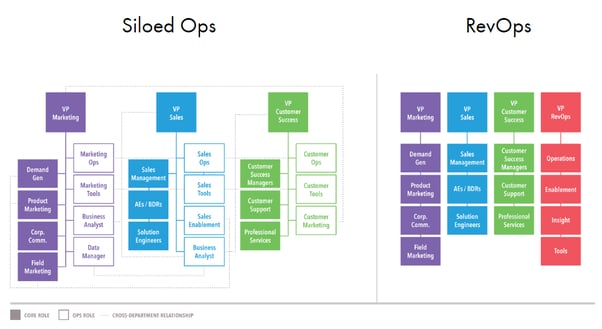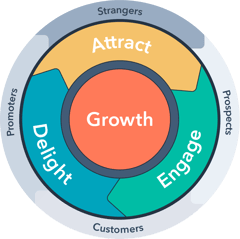RevOps has been gaining momentum as a hot new trend in business. While it’s been around for a couple of years, its spike in early 2021 left many companies scrambling to get onboard before they got left behind.
But even as it grows in popularity, many businesses still don’t understand what RevOps is, what it can do for their business, or how on earth to get started on unlocking its benefits.
Does that sound like you? Read on.
What is RevOps?
RevOps, or Revenue Operations, is a way of doing business that prioritizes and maximizes revenue. It aims to align all the departments (including functions like IT or HR!) of an organization, remove inefficiencies, and hold every aspect of the business accountable for contributing to revenue.
For too long, individual departments have used their own methods and strategies to get the job done. The result is a silo for every function of the business, each unaware of what the other is doing. Even if individual departments try to increase revenue, they have different priorities, goals, and methods than each other. Let’s take a look at a few examples of where businesses typically fail to incorporate a RevOps strategy:
- The marketing department stores data in ActiveCampaign and measures their success based on the number of leads generated.
- The sales department uses Salesforce to keep up with their leads and prioritizes closing a small number of high-value clients.
- The customer service department doesn’t have their own database and are often unaware of a customer’s experience with the business until they begin the interaction.
You can see that in the above (typical) scenarios, RevOps is not being leveraged. Each department is concerned with their own goals. And even if one department implements a strategy to increase revenue, their efforts may be undone by another department that tries a completely different strategy.
By contrast, in a RevOps organization, each facet of the business comes together to make meaningful changes that have an impact on the bottom line.
HubSpot defines RevOps as a strategic approach that centralizes sales, marketing, and customer service operations to provide a consistent experience across the customer lifecycle.
However, we believe that RevOps can be taken further than that, into every nook and cranny of your company: it can impact and benefit even non-revenue-generating departments like IT or HR.

With this kind of holistic approach, you can better support your goals of growing the company by acquiring and retaining new customers. When you see and understand every piece of the business, you can create better customer experiences. This will make your business more efficient and, in time, have a significant impact on your revenue.
Why you need RevOps
Now you have an understanding of what RevOps actually is. But does your business actually need it? Here are four reasons why any business should consider implementing a RevOps team:
1. Departments are working together like never before
In the digital age (and particularly in a post-pandemic remote world), teams share tools and data sources like never before. These resources can be incredibly powerful when used correctly. But if your team isn’t taking full advantage of these tools, the end result is overlaps, redundancies, and frustration.
Sales, marketing, and customer service departments in particular are seeing a lot of changes in recent years. Once, there was a clean hand-off from potential lead to paying customer. Now there is less of a clean transition as more departments are involved with all stages of the customer journey.
While these changes happened gradually, many organizations have not made changes to their business model to keep up. RevOps is the solution to broken processes and helps all departments work together to create a seamless customer experience.

2. Making holistic changes yields bigger results
Even the most well-intentioned department head will have their own personal motivations and opinions. In addition, most individuals don’t have the full picture of the organization. Each department is trying to help the customer in their own way rather than moving in the same direction.
By contrast, a RevOps team will be separate, objective, and bring unbiased opinions to the table. They are better equipped to see everything and know how to introduce unity that will decrease individual effort while increasing overall efficiency.
With this advantage, they’ll be able to make significant changes or identify a number of small improvement areas that add up to big results over time.
3. Team members are getting underutilized
When a team is siloed, you’re likely not using them to their full potential. They may have knowledge or skills that could greatly benefit another area of your organization… but since they don’t know what’s happening in the big picture, they aren’t able to contribute.
RevOps mitigates that problem by involving every department and team member. For example, if an IT employee knows what tools and technology other departments are using, they might recognize a significant gap and be able to make recommendations that contribute to higher revenue.
4. Gaining a competitive advantage is a must
When you implement RevOps, you become more efficient. That gives you the power to do more with what you have and stand strong against competitors.
Further, in the LeanData State of Revenue Operations, 95% of B2B firms agreed that providing a smooth and consistent customer experience is key for increasing revenue. RevOps allows you to create that experience, setting you apart from others in your market.
5. You want increased revenue, right?
Of course, one of the main benefits of RevOps is increased revenue. Consistent revenue growth is a challenge for 78% of B2B companies, and RevOps is a potential solution to this challenge.
Even a small change can have a significant impact on your business. If RevOps can change a marketing process and increase conversion rates by 5%, this will “trickle-down” through the funnel and have an impact on sales, customer success, and beyond.
RevOps allows your organization to scale, since by increasing efficiency, you’ll increase sales without spending more. Once your revenue growth starts to curve upwards, you’ll have more money for hiring, expansion, and so on without the need to spend incremental dollars.
5 Steps to Embrace RevOps in Your Organization
RevOps must be handled by an individual or a team that is distinct from the rest of the organization. This is crucial, as it will allow them to see the big picture and make changes across departments that will have a benefit on the organization as a whole.
Essentially, the RevOps team coordinates the efforts of each separate department and team. Ready to make changes that will increase your company’s revenue? Here’s how to get started:
1. Analyze your data
The first step to getting started with RevOps is to make sure that you’re capturing everything you need.
You need a full understanding of everything that’s going on in the business, from what tools each team is using to the step-by-step process of a customer’s experiences with your business from new lead to loyal customer.
Your main job is to look for inefficiencies and inconsistencies. Even a very small change could make a big difference in the business. Ask yourself: “What one thing could we do today that would have the most impact?”
You also require a full picture of your customer: who they are, and what they want and expect from your brand. Every bit of data, from sales conversion rates to customer onboarding statistics, can give insight into an area that could be creating more revenue.
If you aren’t able to collect and analyze all of this information, your first step should be creating a system that will do so.
2. Document and design your processes
The next stage of RevOps is making changes based on what you discovered during your analysis. One of the most important steps involves mapping out business processes and looking for areas of improvement. Are there any overlaps between departments? Big or small, each change should create consistency and clarity and make processes run more smoothly.
How do individual departments get things done? Processes are often outdated or ad-hoc, meaning team members across divisions (or even across teams) have their own way of doing things.
Don’t neglect your customer in all of this: it’s important to create painless internal processes that simplify employee tasks, but processes need to serve the customer first. Is there any way to make a certain task more efficient, perhaps through automation? What would be the best possible way to solve a particular type of customer problem?
The RevOps team can then design optimal processes, implement them, and make continuous changes over time that will increase efficiency and therefore revenue.
3. Implement and administer tools
What tools are employees using? In many cases, separate departments use different tools. This can result in inaccurate or out-of-date data, manual tasks, and delays and frustration.
RevOps must analyze the tools that each department is using and look for efficiencies and improvements. Could sales, marketing, and customer service be combined into one CRM such as HubSpot? Do team members simply need training on how to use tools to their full potential? What tools would give customers the best-in-class experience they’re hoping for?
4. Redefine and simplify
With new processes, new tools, and perhaps entirely new ways of doing business, your team will need some guidance.
You may need to redefine goals and KPIs for team members. Make sure that you’re measuring success based on contribution towards overall revenue and other objective statistics.
Look for ways to simplify at every stage of the process. For every piece of your operations, ask yourself: is there a better way to do this?
5. Be human
The goal of the RevOps team is to eliminate problems and create a better system that generates more money.
But be sure to lead with empathy and curiosity. Before making changes, try to understand why a department does things a certain way, and consider the impact it has on the customer.
Above all, use RevOps to make jobs easier, not create new burdens. It’s important to strike the right balance between structure and simplification. The results in revenue will reveal themselves in time.
Will you implement RevOps?
RevOps is a powerful way of doing business. It brings together all of your diverse processes, people, and tools into one efficient organization that has no redundancies, no inconsistencies, and can finally start scaling.
Thinking of implementing this approach in your company? Get started on the right foot with an all-in-one CRM like HubSpot… and if you ever have any troubles with your sales or marketing efforts, our team of experts is here to help.



